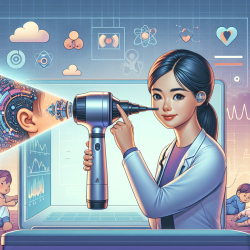Introduction
Middle ear effusions, a common challenge in pediatric healthcare, can significantly impact a child's speech and language development. Traditional methods of diagnosing these effusions, such as pneumatic otoscopy, often rely heavily on practitioner skill and interpretation, leading to variability in diagnostic accuracy. However, a recent study published in Scientific Reports presents a groundbreaking approach using shortwave infrared (SWIR) otoscopy combined with machine learning to enhance diagnostic precision.
The Study: A New Frontier in Otoscopy
The research, titled "Shortwave infrared otoscopy for diagnosis of middle ear effusions: a machine-learning-based approach," explores the use of SWIR otoscopy to visualize middle ear structures and fluid more effectively than traditional visible light otoscopy. This innovative method leverages the unique properties of SWIR light, which penetrates the tympanic membrane more efficiently and is absorbed by water, providing clearer images of fluid-filled areas.
The study involved capturing in vivo images using a prototype SWIR otoscope and processing them with a machine learning algorithm. The results were impressive, with the model achieving over 90% accuracy, sensitivity, and specificity in predicting the presence of effusions.
Why This Matters for Practitioners
For speech-language pathologists and other healthcare providers, accurate diagnosis of middle ear effusions is crucial. Persistent effusions can lead to hearing loss, which in turn affects speech and language acquisition. By adopting SWIR otoscopy, practitioners can reduce diagnostic errors, leading to better treatment decisions and outcomes for children.
Moreover, the integration of machine learning into diagnostic processes represents a significant step forward in automating and standardizing evaluations, potentially reducing the need for unnecessary antibiotic prescriptions and associated side effects.
Implementing SWIR Otoscopy in Practice
While the technology is still in its developmental stages, practitioners can begin preparing for its integration into clinical practice by:
- Staying informed about advancements in SWIR otoscopy and machine learning applications in healthcare.
- Participating in training sessions or workshops on new diagnostic technologies.
- Collaborating with researchers and technology developers to provide feedback and insights from clinical practice.
Additionally, practitioners should consider the implications of this technology for their practice, including potential changes in workflow and the need for new equipment and training.
Encouraging Further Research
While the study provides a promising outlook for the future of otoscopy, continued research is essential to refine the technology and expand its applicability. Practitioners are encouraged to engage in research efforts, whether through direct participation in studies or by contributing clinical data to support the development of machine learning models.
To read the original research paper, please follow this link: Shortwave infrared otoscopy for diagnosis of middle ear effusions: a machine-learning-based approach.










